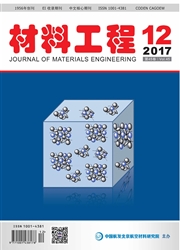

 中文摘要:
中文摘要:
对18CrNiMo7-6合金钢进行弯曲微动疲劳实验,建立弯曲微动疲劳S-N曲线,并对实验结果进行分析。结果表明:该合金钢的弯曲微动疲劳S-N曲线不同于中碳钢材料,也不同于常规弯曲疲劳,而是呈"ε"型曲线特征。随着弯曲疲劳应力的增加,微动运行区域由部分滑移区向混合区和滑移区转变,损伤区的磨损机制以剥层、磨粒磨损和氧化磨损为主。在混合区内,裂纹最易萌生和扩展,且裂纹均萌生于材料接触区次表面。受接触应力和弯曲疲劳应力影响,弯曲微动疲劳裂纹的萌生和扩展可分为三个阶段:初期,在接触应力控制下,裂纹萌生于次表面;随后,裂纹受接触应力和弯曲疲劳应力共同控制,转向更大角度方向扩展;最后,裂纹完全受弯曲疲劳应力控制而垂直于接触表面扩展,直至断裂失效。
 英文摘要:
英文摘要:
A series of bending fretting fatigue tests of 18CrNiMo7-6 alloy steel were carried out, the bending fretting fatigue S-N curve was built up, and an analysis was made on the test results.The results show that, the S-N curve of 18CrNiMo7-6 alloy steel presents a shape of "ε" curve, which is different from the medium carbon steel, and also different from the plain bending fatigue.With the increase of the bending fatigue stress, the fretting regime transforms from partial slip regime to mixed regime and slip regime.The wear mechanisms of fretting damage zones mainly are delaminated, abrasive wear and oxidative wear.In the mixed regime, the cracks are easy to initiate and propagate, and the cracks all originate from the subsurface of contact zone.Due to the different influence levels of the contact stress and bending fatigue stress, the initiation and propagation of the bending fretting fatigue cracks can be divided into three stages.Firstly, the cracks initiate from subsurface under the control of contact stress;then propagate to a larger angle direction under the joint control of contact stress and bending fatigue stress;lastly the cracks propagate vertically to contact surface until fracture failure under the control of bending fatigue stress.
 同期刊论文项目
同期刊论文项目
 同项目期刊论文
同项目期刊论文
 Real time observation and friction vibration analysis of torsional fretting wear of polymethylmethac
Real time observation and friction vibration analysis of torsional fretting wear of polymethylmethac An experimental study on bending fretting fatigue characteristics of 316L austenitic stainless steel
An experimental study on bending fretting fatigue characteristics of 316L austenitic stainless steel Torsional wear behaviors of UHMWPE against Ti6Al4V alloy and alumina femoral head ball in dry condit
Torsional wear behaviors of UHMWPE against Ti6Al4V alloy and alumina femoral head ball in dry condit Comparison on the torsional fretting wear of nitrogen ion implanted pure titanium and Ti6Al7Nb alloy
Comparison on the torsional fretting wear of nitrogen ion implanted pure titanium and Ti6Al7Nb alloy The Torsional Fretting Wear Behavior of Nitrogen Ion Implantation Layer of Ti6Al7Nb Ally Under Bovin
The Torsional Fretting Wear Behavior of Nitrogen Ion Implantation Layer of Ti6Al7Nb Ally Under Bovin 期刊信息
期刊信息
